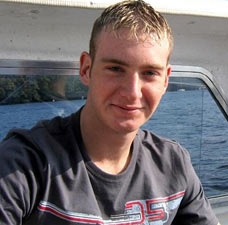 Following on from the report on this blog of the death of the British soldier from the 2nd Battalion, Duke of Lancaster's Regiment, who died after an attack on the Old State Building in Basra, the soldier has been officially named as Kingsman Jamie Hancock, aged only 19 and on his first active tour.
Following on from the report on this blog of the death of the British soldier from the 2nd Battalion, Duke of Lancaster's Regiment, who died after an attack on the Old State Building in Basra, the soldier has been officially named as Kingsman Jamie Hancock, aged only 19 and on his first active tour.Amongst others, that information found its way into The Daily Telegraph both online and print copy, with the by-line of James Burleigh, in what was almost a straight copy-out of the MoD press release.
The choice of Burleigh to front the piece is not particularly odd. As a journeyman hack, he turns his hand to a variety of stories and occasionally writes defence pieces. However, the Telegraph also got its defence correspondent, Thomas Harding, to write a piece on the death of Kingsman Hancock. And, while readers will be aware, I am no fan of Harding, it was actually highly informative.
Now what is really odd is that, not only did the piece not appear in the print edition, it appeared only very briefly on-line before disappearing and, currently, can no longer be found on the paper's own search engine. Under a subject search, it is the Burleigh piece that comes up.
Turning to the Harding story, not only is it informative, it also effectively contradicts the official Army spokesman, Major Charlie Burbridge, who originally told Sky News: "There were bursts of automatic fire, which is an indication that this was not a sniper … These are individual rogue elements of criminal gangs and militias who target our soldiers."
Writes Harding of the dead soldier, he was guarding a British base in the centre of Basra when a sandbagged watchtower (sangar) came under attack from automatic weapon fire. Despite wearing the new Osprey body armour and being protected inside the fortified sangar … he died within minutes as a result of his wounds.
Hancock's company, we learn from Harding, is stationed at one of the most dangerous locations for troops in the centre of Basra, the Old State Building where 200 British soldiers are based. He tells us:
The building comes under attack from rocket propelled grenade and automatic gunfire three or four times every 24 hours with the attacks usually occurring at night. During a recent spate of RPG attacks the 2Bn The Royal Anglians used snipers hidden in rooftops to kill 10 gunmen over a two week period. It is believed that the insurgents use the building to "blood" young terrorists by testing their ability and courage. If the recruits pass then they are offered positions on mortar teams earning up to $300 a firing – the equivalent of almost six month's wages.I tracked down some photographs of the Old State Building and assembled them into the composite below. The first line shows the roof of the building, with a "sangar" being built (and completed), the second line shows the highly fortified perimeter and the third line shows views from the roof, in which some of the fortifications can be seen.

To the story in general, Major Burbridge adds that:
The incident involved a series of bursts from automatic gunfire in an attack carried out by one or more gunmen … The solder guarding the sangar was injured by the gunshots and died within a few minutes. We did not catch the gunmen as they did not hang around after the incident. They fired off a few bursts and then disappeared. It is believed AK47 assault rifles were used in the attack that was probably carried out from a window or building overlooking the British base.With what we wrote in our earlier piece, this really does not convey the impression that the situation in Basra is under control – far from it, with the insurgents able to attack at will a highly fortified British base, heedless of losses. There is a serious war going on out there and we are not being told the half of it.
COMMENT THREAD
